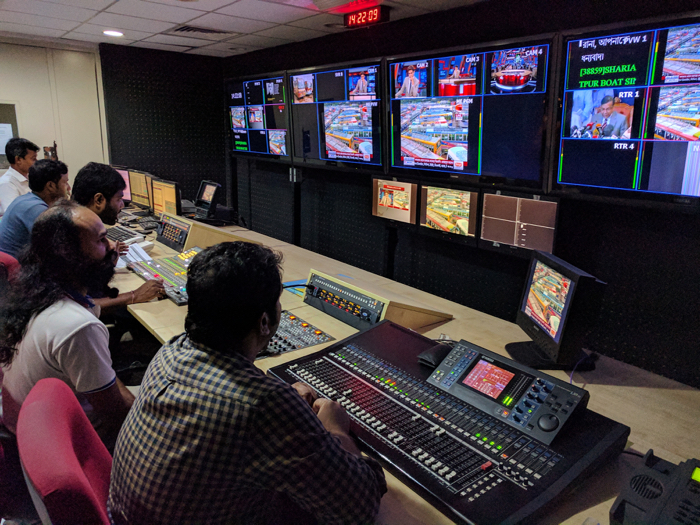
Journalists need to have a system in place for covering a breaking news story in order to know who does what and when.
This training module was written for a journalism training course in Bangladesh attended by seasoned broadcast journalists.
Knowing who does what, why, when, and how
I was asked to create a training module for a 24-hour TV channel in Dhaka where competition is fierce, and where being last with the news isn’t an option.
Prior to the training senior managers sent me a wish-list of what they wanted fixed in their news organisation. They wanted help handling breaking news in terms of:
- Speed – a faster response to breaking news alerts
- Planning and logistics – better coordination of staff and resources
- Improved communications – who is doing what and when
- Organising output – roles and responsibilities
- News management – orchestrating operations
So I shared with them the example of how a commercial international TV and digital news organisation I had worked with in the past dealt with breaking news.
- Confirmation
- A breaking news story has to be confirmed by two of the following:
- A news reporter,
- A member of the bureau staff in the area concerned
- Any other independent sources.
- A breaking news story has to be confirmed by two of the following:
- Action
- The news programme producer or senior supervisor in charge of the news desk liaises with the international and domestic desks and the interactive team.
- Regional specialists are alerted. A decision is taken to go live.
- Collaboration
- The international desk and the domestic desk discuss how they can each bring different elements to the coverage.
- The interactive team meanwhile start to piece together the first elements of the story.
- Depending on the location, one desk covers the main story while the other desk looks for angles that help explain events to their audience.
- Resources are shared wherever possible.
- Convergence
- At the same time the social media team slips into top gear and moves into a well-rehearsed routine which includes updating the online news ticker and providing regular social media updates.
- Chronological live updates are created along with a live blog.
- And all this from a team that is sitting in close proximity to the team producing the TV output.
- They have to be breathing the same air; it is no using having them in a different room, floor, or building.
- Depth and added value
- The main news desk lines up its (regional bureau) contacts and correspondents; often this is supported by guest bookers who help out with research the best experts to talk to and arranging interviews.
- Social media plays a major role when it comes to finding good sources and info snippets or even video and pictures related to the news story.
- Roles & responsibilities
- In the first few minutes of a breaking news story the TV anchor plays a crucial role when it comes to asking the right questions and keeping flow of the output going.
- The initial news-gathering time varies and depends on good sources – which most major news organisations tend to have.
- Planning, booking, research work together in order to add depth and new angles.
- Building on breaking news
- Based on the growing set of information being gathered, the elements of a breaking news show can be built up.
- They are ordered and arranged by the news programme’s producer or senior supervisor and include support from those running the live output and any specialists on the international desk specialists.
- The standard elements are interviews or reporters updates with clips, graphics, pictures, social media, witness accounts etc etc.
- Revising & refreshing
- Then starts a continuous process of updates.
- Material is arranged and re-arranged as needed by the production teams – producers, writers, graphic artists etc – the usual TV and online production specialists.
- The challenge is to stay with the main story, but also to weave in fresh elements.
- Breaking becomes developing
- After a while, breaking news transitions into a developing news situation.
- In exceptional cases, teams on various continents have to take over and keep the story going.
- This is when the international desk becomes particularly important and busy as it then turns into a logistics and resources management exercise.
- Developing returns to regular
- Planners and editors on the main news desk discuss resources with senior management.
- Depending on the state of the budget – and based on the strength of story – resources are allocated or withdrawn based on cost and the likely reach/impact.
- Teams are scaled down or built up case by case.
- Maximum ongoing exploitation
- As soon as breaking news happens, planners are in action working on follow-ups, studio debates and related programmes.
- Most news organisations will try to extract and exploit every piece of content for the maximum benefit of the audience and the news brand.
- Nothing goes to waste, everything is reworked and reused in different output areas and for days ahead, as well as in pick of the week, month, year, etc, etc.
- Online story development
- The online news team will have set aside resources in order to build fact-files, timelines, and info graphics which, in a converged news operation, will be created in such a way as to be able to be used online and on air.
- These interactive assets need to be promoted via the TV anchor in a way that encourages those who want to read about the issue in-depth to remain with brand and move from TV to the online coverage and back.








